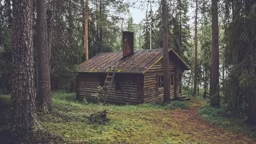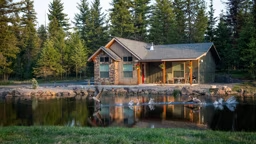The time has come to make sense of the bills, receipts and documents piling up in your home office. It’s true, year-end bookkeeping comes along just as sure as winter winds and spring flowers.
A cabin or second home means additional filings and paperwork, much of it similar to that of your primary residence. But there are significant differences to be aware of, some of which can save you money and a few that can save you a lot of trouble.
Use this year-end checklist to do your cabin owner’s tune-up before tax time.
Meet with a tax professional
To avoid unfriendly interest from the IRS, find out about the important taxation differences between a primary residence and cabin. You can keep it simple – and gain tax advantages – with a little knowledge.
• Mortgage interest on a second home is deductible if you itemize. You also can deduct interest from a second mortgage, or mortgage-based line-of-credit if the loans are secured by the home. As well, property taxes – just like those on your primary residence – are deductible.
• You’re entitled to federal and state tax deductions if your second home has been damaged or destroyed by natural disasters such as fire, flood, earthquake or hurricane (not so for a primary residence, though). In the event of a total loss, you can deduct the fair-market value of the home before the disaster.
• Improvements to your property – new windows, decks, paving the driveway, whirlpool tubs – can be written off against any capital gains when you sell your property. Check with your tax preparer/adviser to find out which receipts are worth saving and which aren’t.
• If you rent out your cabin more than 14 days a year, you must report that income. As well, you’ll be able to deduct expenses associated with that rental income, such as repairs, utilities, insurance, even travel expenses related to maintaining the home. It’s a flurry of paperwork, but you can greatly reduce your tax bill with a bit of bookkeeping.
• If you rent out the cabin for less than 14 days a year, you have no paperwork and a clear conscience. So if your cabin is located near a major event – perhaps a huge golf tournament or an Olympic event – you can pocket rental fees and Uncle Sam won’t need a dime.
Do an insurance check-up
As dreary as it sounds, meeting with your insurance agent once a year is really a good idea. Go. Make sure you have the coverage you think you do and be aware of places you might be exposed to liability.
• Visit with the agent who sold you coverage on your first home. Likely you’ll save up to 10 percent on fees by working with the same agent. Get all your cars, homes, watercraft and perhaps even life insurance with one agent, one company – and the savings increase.
• Consider buying an umbrella policy. Umbrella policies kick in when other policies are exhausted. They pay an injured party’s medical expenses and lost wages, as well as your legal defense. If you own two homes, you have enough assets to warrant the coverage. Experts recommend a minimum of a $1 million policy. The good news is that it’s fairly inexpensive to purchase.
• If your second home is a condo or townhouse, the association pays for insurance on the structure. But you need insurance for liability and anything inside your place – personal contents, appliances and any improvements you’ve made, such as an added hot tub or sauna.
A cabin or second home means additional filings and paperwork, much of it similar to that of your primary residence. But there are significant differences to be aware of, some of which can save you money and a few that can save you a lot of trouble.
Use this year-end checklist to do your cabin owner’s tune-up before tax time.
Meet with a tax professional
To avoid unfriendly interest from the IRS, find out about the important taxation differences between a primary residence and cabin. You can keep it simple – and gain tax advantages – with a little knowledge.
• Mortgage interest on a second home is deductible if you itemize. You also can deduct interest from a second mortgage, or mortgage-based line-of-credit if the loans are secured by the home. As well, property taxes – just like those on your primary residence – are deductible.
• You’re entitled to federal and state tax deductions if your second home has been damaged or destroyed by natural disasters such as fire, flood, earthquake or hurricane (not so for a primary residence, though). In the event of a total loss, you can deduct the fair-market value of the home before the disaster.
• Improvements to your property – new windows, decks, paving the driveway, whirlpool tubs – can be written off against any capital gains when you sell your property. Check with your tax preparer/adviser to find out which receipts are worth saving and which aren’t.
• If you rent out your cabin more than 14 days a year, you must report that income. As well, you’ll be able to deduct expenses associated with that rental income, such as repairs, utilities, insurance, even travel expenses related to maintaining the home. It’s a flurry of paperwork, but you can greatly reduce your tax bill with a bit of bookkeeping.
• If you rent out the cabin for less than 14 days a year, you have no paperwork and a clear conscience. So if your cabin is located near a major event – perhaps a huge golf tournament or an Olympic event – you can pocket rental fees and Uncle Sam won’t need a dime.
Do an insurance check-up
As dreary as it sounds, meeting with your insurance agent once a year is really a good idea. Go. Make sure you have the coverage you think you do and be aware of places you might be exposed to liability.
• Visit with the agent who sold you coverage on your first home. Likely you’ll save up to 10 percent on fees by working with the same agent. Get all your cars, homes, watercraft and perhaps even life insurance with one agent, one company – and the savings increase.
• Consider buying an umbrella policy. Umbrella policies kick in when other policies are exhausted. They pay an injured party’s medical expenses and lost wages, as well as your legal defense. If you own two homes, you have enough assets to warrant the coverage. Experts recommend a minimum of a $1 million policy. The good news is that it’s fairly inexpensive to purchase.
• If your second home is a condo or townhouse, the association pays for insurance on the structure. But you need insurance for liability and anything inside your place – personal contents, appliances and any improvements you’ve made, such as an added hot tub or sauna.
Get a financial planner
The day will come when your wonderful cabin will have to either be sold or passed on to the kids. Plan-ning ahead can keep the cabin in the family. Even better, plan how to keep the equity in your cabin without paying capital gains taxes.
• Consider creating a trust that will manage your assets in the case of illness or death. It sounds fancy, but it’s a basic tool to shelter your property and assets from probate court. It’ll also keep the family from having to sell the cabin to pay the tax man. A competent professional will help you evaluate what you’re trying to accomplish, and find the proper trust structure to meet those goals. Spending a few hundred dollars on a planner is a good price for peace of mind.
• Do some capital gains planning. Tax code allows folks to sell one primary home with no capital gain taxation, up to $250,000 for a single filer or $500,000 for joint filers. That leaves second homes wide open to huge tax bills. There are perfectly legal ways, however, to end-run the rules. A couple can keep one home in a husband’s name and the other in a wife’s, for example, allowing each to reap the benefit of capital gains protection. Additionally, some families purchase a life insurance policy on the cabin owner to cover the expected tax event.
Now, doesn’t that feel better? Everything in order, the file cabinet closed on a well-organized life. It makes getting back to reading that novel or dipping that line into the water all the sweeter.
Jana Voelke Studelska was glad for this writing assignment. It was a well-needed reminder to get her own file cabinet in order.
The day will come when your wonderful cabin will have to either be sold or passed on to the kids. Plan-ning ahead can keep the cabin in the family. Even better, plan how to keep the equity in your cabin without paying capital gains taxes.
• Consider creating a trust that will manage your assets in the case of illness or death. It sounds fancy, but it’s a basic tool to shelter your property and assets from probate court. It’ll also keep the family from having to sell the cabin to pay the tax man. A competent professional will help you evaluate what you’re trying to accomplish, and find the proper trust structure to meet those goals. Spending a few hundred dollars on a planner is a good price for peace of mind.
• Do some capital gains planning. Tax code allows folks to sell one primary home with no capital gain taxation, up to $250,000 for a single filer or $500,000 for joint filers. That leaves second homes wide open to huge tax bills. There are perfectly legal ways, however, to end-run the rules. A couple can keep one home in a husband’s name and the other in a wife’s, for example, allowing each to reap the benefit of capital gains protection. Additionally, some families purchase a life insurance policy on the cabin owner to cover the expected tax event.
Now, doesn’t that feel better? Everything in order, the file cabinet closed on a well-organized life. It makes getting back to reading that novel or dipping that line into the water all the sweeter.
Jana Voelke Studelska was glad for this writing assignment. It was a well-needed reminder to get her own file cabinet in order.
 Lumaxart2d/ dreamstime.com
Lumaxart2d/ dreamstime.com  Lumaxart2d/ dreamstime.com
Lumaxart2d/ dreamstime.com 









